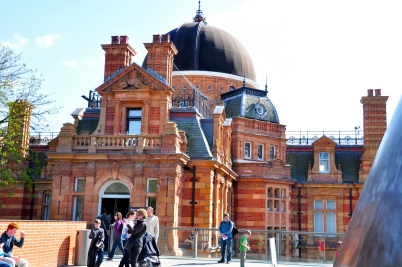Site 795 – Maritime Greenwich, United Kingdom
As a child I used to think that Greenwich was pronounced similarly to “sandwich”.
My understanding expanded slightly when I came to learn about times zones. Greenwich had been used as the reference point for clock-setting around the world for hundreds of years, despite the French being French and insisting until 1911 that Paris time should be the default. These two snippets of information comprised the totality of my knowledge of Greenwich until I visited in 2010.
 Maritime Greenwich is ridiculously easy to get to, being a suburb on the eastern side of London accessible from the creepy and robotic Docklands Light Rail. London is known for being cold and damp, so the odds of the site being “atmospheric” were always in my favour. It was grim on the morning of my visit, which actually improved the nautical atmosphere. Gusty winds and big dollops of rain falling around you add a certain something. This is capitalised upon by the local shop-owners and publicans who have festooned their window-displays with bits of knotted rope, ships’ wheels, and strings of jaunty bunting celebrating Britannia ruling the waves.
Maritime Greenwich is ridiculously easy to get to, being a suburb on the eastern side of London accessible from the creepy and robotic Docklands Light Rail. London is known for being cold and damp, so the odds of the site being “atmospheric” were always in my favour. It was grim on the morning of my visit, which actually improved the nautical atmosphere. Gusty winds and big dollops of rain falling around you add a certain something. This is capitalised upon by the local shop-owners and publicans who have festooned their window-displays with bits of knotted rope, ships’ wheels, and strings of jaunty bunting celebrating Britannia ruling the waves.
The general area of Greenwich had a long history of settlement before being swallowed by greater London. Various un-named bronze-age people and some Vikings settled here before the Normans claimed the lot, inaugurating a thousand years of British monarchs visiting, building something, and then leaving again. The maritime aspect of the site surprised me, as it’s actually a long way from the sea. Coming from Australia, a country of conspicuously rubbish rivers, I had forgotten that rivers like the Thames are navigable well upstream from the sea, even by modern vessels.
 The core of the World Heritage site is a collection of buildings of dating from the 17th and 18th century, many designed by Inigo Jones or Christopher Wren. The Queen’s House (Jones) was the first building in Britain done in the Palladian style, which was then replicated across the length and breadth of the land with varying degrees of grandeur and competence. The naval aspect is represented by the Wren’s Royal Naval Hospital, which later became the Royal Naval College, and then even later the (Old) Royal Naval College. This is a vast, and vastly beautiful ensemble of near-perfect symmetry set against the river and huge green lawns.
The core of the World Heritage site is a collection of buildings of dating from the 17th and 18th century, many designed by Inigo Jones or Christopher Wren. The Queen’s House (Jones) was the first building in Britain done in the Palladian style, which was then replicated across the length and breadth of the land with varying degrees of grandeur and competence. The naval aspect is represented by the Wren’s Royal Naval Hospital, which later became the Royal Naval College, and then even later the (Old) Royal Naval College. This is a vast, and vastly beautiful ensemble of near-perfect symmetry set against the river and huge green lawns.
Perhaps more important, and certainly better known, is the Royal Observatory on a hill in Greenwich. It’s quite small and unassuming, but was critically important for the development of the modern world due to the hard work of its astronomers. Their careful observations of the heavens laid the foundation for modern astronomy, but also produced the formulae which sailors used to calculate their location on the surface of the earth. The fact that we still use Greenwich Mean Time is an historical accident but is far from unimportant.
For those (like me) who aren’t particularly conversant in the various styles of architecture on display here, a way to think about this site is as one of the birthplaces of the scientific revolution. Many of the innovations of the age, such as accurate timekeeping and observation of the earth’s movement were developed or perfected here, and we still rely on these innovations today. To my mind the really interesting element is how these abstract scientific developments have been married to Britain’s maritime heritage, allowing the great naval power of the age to remain dominant through a combination of technology and practical ingenuity. Maritime Greenwich is a kind of testament to the first high water mark of British power in the 17th and 18th centuries. Britons are justifiably proud of their record of generating scientific advances which are then turned to practical applications, and the remaining buildings of Greenwich display that in a way that shows just how long it’s been going on.
But given all of this, one of the things that I really liked about Greenwich was that after I’d had my fill of grand buildings and observatories, it is entirely possible to wander back into Greenwich town and settle into one of the nautical-themed pubs for some beverages. And a meal. And more beverages.
Strictly in the interests of research, I might add.






One thought on “The birthplace of science – Maritime Greenwich, United Kingdom”